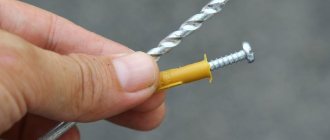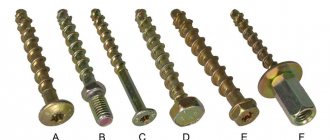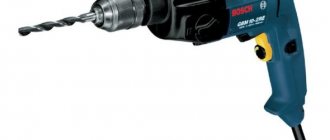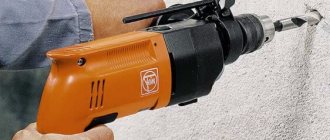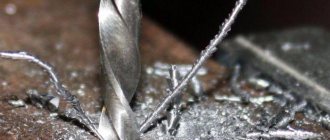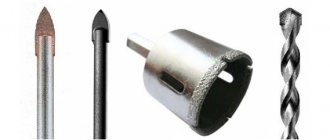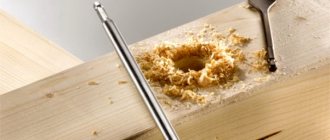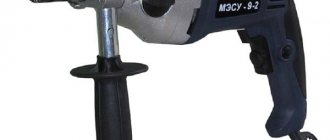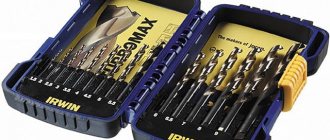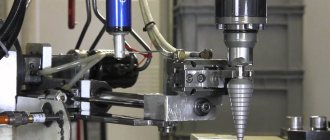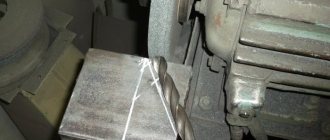Drilling into concrete is very different from making holes in wood or metal. And although in all cases a power tool is used, the cutting attachment on it is strikingly different. Let's look at how to choose the right concrete drill for a drill. We will also analyze the technological process of drilling a brick wall.
Drilling concrete Source stroylandiya.ru
Drilling holes in the wall correctly: general rules and recommendations for what to drill
In order to correctly drill a wall, you need to take into account the material from which it is made, based on this you need to select a tool.
- When working, hold the tool correctly. For example, a drill should be held straight in your hands and enter the surface in a vertical direction;
- for convenience, use an additional handle;
- Depending on the surface material, select the necessary drills.
- concrete, stone, brick wall - use a carbide drill, usually a Pobedit one;
- metal – metal drill;
- tiles, ceramic tiles - special drills for these materials, sometimes they can be replaced with a drill for concrete with Pobedit surfacing;
- Chipboard, wood - for holes smaller than 10-12 mm, a metal drill is suitable; for larger ones, special wood drills are used.
Drill for concrete, brick and stone
It should be noted that the person who invented the drill to make it easier to work with the material could not even imagine how many new engineering solutions would be produced based on the drill. An example of this would be a foundation on screw piles. This engineering solution made the construction of a safe and simple foundation much easier. A drill for concrete (as well as for stone, brick, etc.) is fundamentally different from a conventional drill. After all, if you drill concrete with an ordinary drill for working on wood or metal, it will instantly become dull and become completely unusable.
For this reason, special concrete drills are made using a special material called “win”. And the drill tip made from it is called “Pobedite”. On sale in hardware stores, you can see metal drills with pobedit tips on the ends. These are “pobedite” drills. We will talk about them in more detail later in this article.
In any case, these are very reliable, durable drills, because pobedit (a composite cermet material consisting of an alloy of cobalt and tungsten), which has no analogues, is close in strength to diamond. However, quality, as is known, directly depends on the manufacturer.
Pobedite drills can be used not only for concrete, but also for stone and brick. These are reliable drills. However, for stone it is best to use a diamond drill bit. It is more durable, but also expensive. For wood, it is best to use metal drills. We will look further at how to use them correctly and wisely in your work.
Tools for work
For work they use different tools, the main ones: drill, hammer drill, screwdriver. There are nuances to using each.
Drill
The tool is suitable when you need to make several holes. You can use a regular drill. When plunging a Pobedit drill into the body of the wall, sometimes you need to break the concrete with a punch that matches the diameter of the hole. This is necessary when the drill begins to get stuck in the surface, bumping into areas that are too dense. The process is quite labor-intensive.
For greater efficiency, you can use universal drills that have diamond coating. They are installed only on a conventional drill or on a tool where the vibration function is disabled.
For large-volume work, an impact drill and drills with pobedit tips are used. They are designed for holes up to 12 mm. The drill is suitable for working with metal and concrete.
Hammer
A hammer drill is a universal tool. It can be used to make a hole in a wall made of wood, tiles and concrete.
The tool has several functions - drilling, hammer drilling and impact mode. To make a hole, you need to select the desired drill depending on the surface and carry out the work by selecting the mode.
Screwdriver
A screwdriver is one of the most popular tools for repair and construction work. With its help you can tighten and unscrew screws, drill wood, metal, chipboard, plywood, tiles, plywood, lightweight concrete.
Which nozzles to choose
A specific nozzle is used for each material:
- concrete, brick, stone - drill with a carbide plate or pobedit;
- tiles, glass - cone-shaped drills with diamond coating;
- metal – spiral drill with a cylindrical cone;
- wood, drywall - for holes of different diameters, drills are used: feather, ballerina, screw, saw bits for wood;
- foam concrete - pobedit drills.
Is it possible to do without a drill and hammer drill?
Make a hole without a drill or hammer drill, but not in a concrete wall. To do this you will need a bolt or a punch.
The working end of the tool is applied to the place where the hole will be. On the opposite side of it, you need to strike hard, rotating the tool after each turn.
Features of working with a drill
In order to drill a hole in a very solid (load-bearing) wall, an ordinary drill (no matter what kind of drill we put there) will clearly not be enough. For this purpose, special drills are used - with a hammer drill. And also special drills for concrete sds. Usually, they are marked or “sds-max”. Their distinctive feature is also their cylindrical tail. A drill bit for a hammer drill for concrete is used, as the name implies, in a drill with a hammer drill, when it is necessary to drill a hole in a load-bearing wall or in another surface of increased hardness. That is, in situations where a regular drill (as well as an impact drill) will not help. An impact drill (a special drill for concrete) comes in several types. Thus, concrete drills, called shallow drills, make it possible to drill small holes, while auger drills make deeper and wider ones. Spiral-shaped impact drills help cope with a more difficult task - making larger holes (even up to three centimeters).
If you need to drill a very large hole (for example, for a socket or switch), up to 12 cm in size, use a concrete core drill. It allows you to obtain recesses of up to 12 cm in particularly durable materials. You can see two types of core drills on sale: pobedit and diamond. A Pobedit drill for concrete has Pobedit teeth on the working part, while a diamond drill has diamond sputtering.
Concrete drills come in different diameters - from 4 to 12 mm. A drill bit for a large-diameter concrete hammer drill is rarely used in everyday life. As a rule, it is most often needed by professionals who are constantly renovating premises.
However, there is still a certain feature in the size of drills that should be taken into account when using them - the larger the diameter of the drill, the longer it is, and vice versa, the shorter the drill, the thinner it is. And this is not surprising, because a thin long drill will simply break during operation, unable to withstand the shock load on it.
How to drill without dust: options, the better
Construction work is always accompanied by dust and debris, but using some recommendations and tips, it can be significantly reduced:
- During operation, the hammer drill leaves a slight dust, so that it does not fly around the room, use a construction vacuum cleaner at the same time. Some brands of tools have a built-in vacuum cleaner, which makes the task easier;
- using a drill, it is best to either make a jig on the end or a bag, or make an envelope under the hole so that the debris falls into it.
How to drill holes in a brick wall: choosing tools and attachments
To make a hole in a brick wall, a hammer drill with a drill or an impact drill are suitable; the latter is most often used. Its power must be at least 600 watts, the minimum number of revolutions is from 2500 per minute. It is best to use a drill with continuously adjustable power and a quick clamp function.
Using the hammer drilling function, the drill becomes identical to a hammer drill. Increases speed and ease of operation. To make a hole in a brick wall you need to use the dynamic impact method. Without this, the drill will not be able to engage the inside of the brick.
How to drill a load-bearing wall with a hammer drill in a panel house
In most panel houses, the walls are made of concrete; in order to make a hole with a hammer drill, you need to use pobedit drills.
In addition to them, you can use special crowns. They have soldering around the circumference. When using them, you need to disable the hammer drill's impact function.
Specialists use diamond drilling, which requires powerful equipment and skills.
How to properly drill a reinforced concrete pipe with a hammer drill
When using an impact drill for reinforced concrete, you need to use the “perforator” mode and pobedit drills. First, the hole is made smaller, then larger. The drill needs to be cooled periodically.
Important! When working with concrete, you need to avoid hitting the reinforcement, otherwise the drill will break. Using a special device you can check where it is located.
How to make a hole in a concrete wall with a drill
It is difficult to drill into a concrete wall with a conventional drill. You need to install victory drills and select low speeds. A dowel is inserted into the desired location to help the tool pierce the surface. Next, drilling should be alternated with striking the dowel.
If the drill does not have a speed control, then it will not be possible to make a hole.
How to make a hole in a concrete wall in an apartment with a drill
For a small hole, you can use a punch. Most conveniently, it can be made from a drill, 8 mm in diameter. The end is sharpened sharply. The drill is placed in the desired place, rotated, while simultaneously hitting it with a hammer. Wet the drill periodically to make it work longer.
Drilling technology
Let's figure out how to drill a hole in a brick wall. After all, in addition to the working attachment, the tool itself is also important. It will depend on how much energy is spent on work. And the latter can be done in three ways.
Manual drilling
The method is quite archaic. But if you don’t have a power tool at hand, and the work is slow, you’ll have to work hard. You will need a bolt and a heavy hammer. The punch is applied to the wall strictly perpendicularly, and they begin to hit its head hard.
A bolt is a piece of pipe of different diameters. The back side is thickened, but retains a through hole. On the working part, sharp teeth are made that bite into the concrete surface. Every three blows the tool rotates slightly in the hole.
Concrete or brick chips are periodically removed from the pipe. The hole is selected until it reaches the specified depth. For small diameter passages there are special punches. They are a steel rod of varying thickness with pobedit soldering on the working part.
Manual bolt for concrete Source prom.st
Electromechanical process
The operation is performed either with a hammer drill or a hand drill. But the latter must have a shock system. Otherwise, the process will drag on indefinitely, and the drill will fail faster.
And before drilling a brick wall, you need to decide on the depth, diameter and type of hole. If you need to make a hole for communications, it is better to carry out the work in three stages.
First, a through hole of small diameter is drilled. Then it expands to half, on one side. And the operation is completed on the opposite part of the wall. This way you can get a neat hole, without torn edges.
Automatic process
So-called diamond drilling is carried out using expensive professional equipment. The operator must have sufficient experience and proven qualifications. The cost of the operation is quite significant, but completely justified.
The hole can be made at almost any angle and to a depth of up to 40 cm. Moreover, the entire process is silent and dust-free. The hole turns out perfectly smooth, without chips or cracks. And the operation itself takes very little time.
Diamond drilling of a wall Source adelmsk.ru
Work rules: tips
When working with tools, you must follow safety rules and general recommendations:
- 1) When performing work, protect your respiratory system, dust is harmful.
- 2) If you work outside, you need to install fences at 2.5 meters.
- 3) When performing work at a height of more than 1.5 meters, use a strong base - scaffolding or a goat.
- 4) When working with a tool, the speed must be turned on smoothly, and in no case should it be turned off when it is in the body of the wall.
- 5) When drilling through plaster, you must carefully study the communication plan so as not to hit anything.
- 6) It is strictly forbidden to drill through the decorative coating.
- 7) Choose the right drill bits for each surface.
- Wet the drill with water to prevent it from overheating.
How can I repair a large drilled wall?
You can seal unnecessary holes in the wall using a special building mixture. It provides strength and durability. The composition must be selected depending on the area and type of defect.
Using putty, you can level the surface, including concrete. There are several types of putty:
- cement – used in exterior and interior decoration, suitable for concrete. Durable and moisture resistant. It dries for a long time and often in a mesh pattern, which requires re-application;
- gypsum - used in dry rooms, is not resistant to water and is afraid of temperature changes. Does not crack when applied, so you can immediately apply a thick layer;
- acrylic – finishing. It needs to be applied in a thin layer, so it is suitable for small defects.
Read also: Btb10 800bw how to check with a tester
None of the mixtures are used to seal through holes.
Polyurethane foam is a universal material. There is one-component (used without preparation) and two-component (when used, a construction gun or mixer is used).
When applied, the foam increases in volume and fills the required space. It hardens and gives high-quality density. Deep holes can be sealed.
The repair mixture is suitable for eliminating large defects. It has good adhesion, is frost-resistant, strong and durable.
When you decide to make a hole, carefully read the rules and recommendations. Choose a tool, depending on the composition of the surface, and a drill. If you are not confident in your own skills, then entrust the work to specialists.
Advice from an experienced master
A good owner always has several drills of different types for working with a drill - drills for wood, metal, brick and concrete. To work with a drill on concrete, it is best to stock up on different drills, including Pobedit drills and metal drills. This is necessary so that, during the drilling process, when faced with the fact that the drill rests on the metal (this happens when there is metal reinforcement under a concrete slab), it would be possible to easily and quickly rearrange the drills - replace the concrete drill with a metal drill - and continue work without delay or delay. And when the metal runs out, you can put back the sds concrete drill. Those experienced craftsmen who have been working with a drill for many years know how to sharpen the drill in such a way that it can be used to work both on concrete and on metal, but for a person who has never encountered this before, this is an elusive task, and even better don't start and don't try.
It is also very important that when working with a drill, the drill does not overheat. To do this, it must be periodically cooled regularly (approximately every 15-20 seconds of operation). To do this, pause and lower the metal drill into a small container of cold water. Hold the drill there for a while, and then, when it cools down, continue the drilling process. There is no need to dry it. However, this rule only applies when drilling metal. When drilling wood, there is no need to cool it - it does not overheat. And when working with a Pobedit drill, it is not cooled in water - only in a natural way. We worked, drilled for half a minute, turned off the drill. We waited until the drill cooled down, and only then we continued working. You cannot use any cooling liquid during the operation of the Pobedit drill.
There is also a situation when, during the drilling process, we come across a stone under a concrete base. For stone, a regular sds concrete drill will not work - we take a chipper in our hands. After completing the work with the stone, we return to the concrete drill.
If in the process of work you have a need to drill one or several holes, no matter what diameter, not in an ordinary wall (interior partition), but in a load-bearing one, then it is best to use a hammer drill for this, and not an ordinary drill. You should not try to do this with a household drill, it is useless. And, of course, in this case we will need a drill bit for a concrete hammer drill.
But when working with ceramic or tiles, a hammer drill is not needed. It will only crack the tiles. You don't need an impact drill either - it will also crack and ruin your entire tile. Forget about a concrete drill bit. Only a household drill with a regular, small-diameter metal drill will help here.
You can use a Pobedit drill bit for drilling ceramic or tiles (not including the hammer drill mode).
Those drills that become dull during work can be easily re-sharpened - metal ones with regular sandpaper, and pobedit ones with a diamond disc. However, if you choose expensive, high-quality drills from well-known manufacturers in the store, you are unlikely to ever need to sharpen them - they simply do not get dull.
Further, upon completion of this review of drills, we offer you to watch a short video on the topic we discussed.
Useful video
Drilling a brick wall includes the practical implementation of certain skills, as well as preparatory processes regarding the tool used and the surface we process, in fact, the brick wall.
The quality of the final result depends on the type of drill used. The latter must have a strength exceeding the strength of the brick used at the time of laying. Typically, pobedit drills with a diameter of 4, 6, 8 and 12 mm are used, respectively.
Tools and equipment
The list presented below is optimal regarding the drilling process, or more precisely, the implementation of the task without interrupting the process itself.
So, the list consists of the following names:
- impact drill;
- dowels;
- drill (pobedit / 4 – 12 mm);
- curly screwdriver;
- metal detector with limited range;
- cold water poured into any convenient container;
- metal core;
- eye protection element.
Tool preparation
The tool used in the process of drilling a brick wall is an impact drill. Such a drill must be powerful, which means it must have at least 600 W and 2500 thousand revolutions per minute. The main feature that is worth paying attention to is the ability to smoothly adjust the speed to maximum.
If buying a drill is still an upcoming event, then the emphasis should be on a drill with reverse rotation, as well as a self-clamping chuck. The latter eliminates the need to constantly use a key to clamp drills, although one is included in the kit.
The presence of a shock function is a prerequisite, since its absence will undoubtedly lead to:
- overheating of the drill, and in particular surfacing from pobedite (sudden wear of the cutting part);
- normal drill pressure without engaging the cutting edge, since only the static load increases.
About the design of shanks
The types of nozzles under consideration are classified into two main types according to the shape of the shank:
- Cylindrical - these are the most common, and are designed directly for impact drills with collet keys or keyless chucks
- Hexagonal shapes - this shank on concrete drills has an identical design with bits for screwing and unscrewing fasteners. Such nozzles with hexagonal shanks have a diameter of no more than 8-10 mm, and why this is so, we will consider further
When drilling concrete, and especially reinforced concrete, the drill may stall (get stuck). Due to the special cylindrical design of the shank, when it jams, the nozzle rotates, eliminating overheating of the motor and licking of the gear teeth. When using drills with hexagonal shanks in a collet chuck, the possibility of them turning when jammed is eliminated. As a result of getting stuck, not only the tool, but also the person can suffer. This is why manufacturers do not produce concrete drills with a hexagonal shank for drills larger than 8-10 mm.
This is interesting!
Drills with hexagonal shanks can also be used in the design of screwdrivers, where the chucks have a special hexagonal shape of the landing splines. There are also devices with tapered shanks that are designed for drilling machines, but they are not suitable for drilling into walls.
Preparatory work: positioning relative to the brick wall
Preparatory work regarding the brick wall itself immediately before drilling is more of an informational nature than a “strategic” - design one. From the point of view of safely performing such work, it is necessary to use the metal detector that was indicated in the list above.
Its practical application immediately before drilling will eliminate the possibility of damage to wiring, internal heating systems, as well as various reinforcing components.
Marking sockets, switches and lamps is the final stage of preparation. Taking into account the features of laying electrical wires from the above-mentioned “points” to the distribution box, and this is usually a vertical laying, but not excluding the possibility of a diagonal one, we determine the drilling location.
Despite the expected accuracy in choosing the drilling location, the first 10-20 mm deepening must be done with a screwdriver. Using this will allow you to timely identify communications recessed in the plaster, as well as avoid their critical damage.
Direct drilling into a brick wall
The answer to the question of how to drill a brick wall with a drill can be obtained solely through independent practical experience. So let's get started!
The drilling process itself, regardless of the finish of the brick wall or its complete absence, begins with making a mark. The hole in the wall is marked with a core. Why do you need a mark? After using the core, a slight depression remains, which reliably fixes the cutting part of the drill at the initial stage of work.
The drill must be kept level throughout the entire drilling process, otherwise the cutting element (Pobedit drill bit) will break.
The human factor affecting the drill and the static load on the drill are interrelated quantities. The first, namely “pressure” on the drill, should be smooth and soft, despite the need for significant loads in order to achieve the final result.
If significant static loads can be dealt with by regularly cooling the drill (returning the tungsten and cobalt alloy to its original state), then uniform drilling is the result of a uniform and smooth impact on the tool itself.
Using coolant (water) during drilling may damage the tool. The working cutting Pobedite drill is lowered into the water only 70% of the working length, that is, the one that remains after fixing the latter into the chuck.
The drilling process is monotonous and does not require special skills, but it does require considerable attention. So, for example, the latter will help to identify and, of course, overcome a burnt brick, if, of course, one came across the drilling path. You can identify a burnt brick by the color of the dust. Usually it is black.
Passing such sections must be carried out at low speeds, which, in turn, must be combined with the activation of the shock function. Observing these two conditions, as well as making efforts towards the tool itself, it is necessary to carefully control the heating of the Pobedit drill.
Drilling holes measuring 12 mm requires a slightly different approach, namely the consistent use of all of the above sizes of Pobedit drills. To start drilling a brick wall for a 12 mm hole, you need to start with a 4 or 6 mm drill.
One of these drills reaches the planned depth, then the width of the hole is expanded with a 10 mm drill. After the depth in relation to the previous drill size has been achieved, a similar action should be repeated with a 12 mm drill.
Taking into account this technology to achieve the required hole diameter, namely a diameter of 12 mm, the final result will be achieved much faster, and, at the same time, without unnecessary effort. Regarding how to quickly and efficiently drill any brick wall with a drill in order to obtain a diameter of, for example, 30 mm, you should pay attention to diamond drilling.
When improving an apartment, it becomes necessary to mount all kinds of objects on the walls and ceiling - photographs, paintings, lamps, mirrors, curtains, shelves, TV, baseboards and much more.
In order to hang a photograph or a small painting, of course, you should not drill into the wall. It is enough to hammer in a small nail. Not every carnation is suitable for this task. It is best to use dowels - nails from fastening brackets that secure computer network cables to walls. These cloves are of sufficient length, thick and hardened. It turns out that it can even be driven into a concrete wall.
Performing the operation of drilling holes in walls with modern equipment with power tools will not present any greater difficulty if you know how to drill correctly. It will save you from unnecessary cleaning and keep your property intact if you use a jig for dust-free drilling.
How to drill a wall
A better tool than a hammer drill for drilling holes in brick and concrete walls has not yet been invented. But rarely does anyone have the luxury of having such an expensive tool on their household. Usually buy an electric impact drill.
Drill selection
When purchasing an electric drill, you need to be guided by the following technical characteristics.
The power of the drill must be at least 600 W. Revolutions up to 2500 per minute and the ability to smoothly adjust them from zero to maximum. The presence of reverse rotation (switch for the direction of rotation of the drill clockwise or counterclockwise). The best chuck is a quick-release chuck; you won’t have to waste time clamping drills and constantly searching for a lost key. The diameter of drills clamped in the chuck is up to 12 mm.
Read also: Can Nefras be degreased?
The presence of a switchable hammer drilling function. Of course, when this function is enabled, the drill will not become a full-fledged hammer drill, but drilling walls will be much easier and faster, and here’s why. Brick, cement and concrete withstand static load - pressure very well. But they are easily destroyed by dynamic influences - impact. Karatekas, with a strong blow, easily break a brick in two with the edge of their palm. When drilling with a drill without a hammer function, there is simply pressure from the drill and it is difficult for the cutting edge to catch on to the material, so drilling is slow and the drill becomes very hot due to friction. Drilling with impact is completely different. Upon impact, the drill punctures a part of the material with its cutting edge, and, falling with an impact into the formed recess, breaks off a portion of particles of the material. Something similar to chiseling is happening.
Drill selection
Walls made of wood, plasterboard, and foam concrete can be successfully drilled with an ordinary drill. For walls made of brick, stone or concrete, you need a carbide drill. It differs from steel by cutting edges made of carbide material welded onto a regular drill, usually Pobeda. Less commonly, artificial diamond.
The pobedite insert is clearly visible at the end of the top drill. It is enough to have 2 Pobedit drills with a diameter of 6 and 8 mm on the farm.
Using drills with pobedite surfacing, you can drill a hole no more than 10-15 cm deep. For drilling to greater depths, for example, to drill through a wall, use a drill. Drills for drilling brick and concrete walls are up to one meter long and are designed for drilling holes only with a hammer drill. Even the cutting edges of the drill are made not sharp, but rounded to increase their wear resistance. A drill with a hammer function can also be successfully drilled with a drill.
Drills come with a shank diameter of 10 and 18 mm, with special grooves of the SDS+ or SDS-max standard for fastening, but they also clamp well in a regular jaw chuck. The standard and diameter of the drill are stamped on its shank.
If you need to drill through a thick wall, for example half a meter, then the passage is carried out in several stages with drills of the same diameter, but of different lengths. This is necessary for safety and faster drilling. First, drill the wall with a 20 cm long drill to a depth of 10-15 cm, then with a longer drill to a depth of 30-35 cm and finish drilling with a 50 cm long drill. The drill for such work must be powerful enough. Of course, the drill is not designed for such a load and its use is permissible only in exceptional cases. To perform this type of work, it is better to rent a real hammer drill.
Features of concrete drills
If a special alloy is soldered onto the cutting part of the tool, the drill turns from a regular one into a pobedite one. This is the name given to ultra-strong steel, consisting of 90% tungsten carbide and 10% cobalt. Pobedit's strength parameters are not inferior to diamonds, but are much cheaper to obtain.
Differences between drill tips:
- Wood needs a very sharp part that will stick into the surface.
- For metal, a pointed part is not necessary. The main part is the cutting cone-shaped part.
- The concrete tool generally has a fairly blunt tip. And all the work is done by pobedite surfacing.
Drills with reinforced tips are available in two types. And the only difference between them is in the shanks. For electric drills, the cylindrical end of the tool is made solid. Hammer drills have grooves on the shank.
The ends of the cutting tools for hammer drills are divided into two types, which have their own markings. There are drills designated SDS-max, where the recesses act as a convenient lock. The tool is fixed in the chuck by simply snapping it into place.
Differences between drill tips Source kwitka.com.ua
The SDS-plus shank has a slight thickening at the end. It helps the drill during the percussive movements of the hammer drill. This makes it easier for the tool to bite into durable concrete. Therefore, all professionals choose drills with this marking.
A concrete drill has another name. People call him Boer. And the reason lies in the size of the instrument and its shape. Typically, most drill bits are long enough to allow you to drill right through the wall.
And according to their shape, drills are divided into three types:
- Screws allow you to go much deeper.
- Spiral-shaped holes can be made with large diameters.
- Gentle ones are convenient when you need to get small and shallow passages.
When you need to make holes in walls for communications, use core-type drill attachments. They allow you to form holes up to 12 cm in diameter. Core drills for concrete drills are made in the form of a tube, which is fixed on a solid steel rod. The latter is made as a centering drill.
The working part of the crown is made in the form of teeth. They consist either of pobedite or diamond dust is applied to the metal. The latter option, although more expensive, is preferable. Because working with such a tool is much more convenient.
Diamond bit for concrete Source rgbk.ru
See also: Catalog of companies that specialize in the reconstruction and rebuilding of houses
How to drill a wall
Before you start drilling into a wall or ceiling, you need to make sure that there are no electrical wires or other cables running under the intended location in the plaster. Otherwise, you can damage the electrical wiring and get under voltage yourself.
How to avoid getting caught in a wire
It is necessary to inspect the wall for the presence of a switch or socket. Usually, wires extend upward from them in a vertical direction to the junction box. But verticality is the ideal case. This rule is rarely observed in practice by electricians; to save wire, hidden wiring is often laid diagonally. Here's an example of this. When I made repairs and moved the counter to another place, after removing the old wallpaper the following picture opened. You can clearly see how the wire leading to the meter was laid.
But still, the wire will run from the switch to the nearest box. The wire will also go from the chandelier to the nearest box.
Typically the wires are recessed to a depth of no more than 10 mm. To check, use a blunt instrument, such as a screwdriver, to dig into the wall to this depth. If no wires are found, then you can start drilling. And yet, just in case, up to a depth of 20 mm, you should not press too hard on the drill and after deepening every couple of millimeters, visually check whether the wire is caught.
There are special devices that allow you to determine the location of wires in the wall. Here are some of them that are not expensive, made in China, but nevertheless work well. It also has a metal detector function, which allows you to identify the location of metal reinforcement in concrete walls. The device allows you to find copper electrical wiring at a recessing depth of up to 10 mm. Electrical wiring made of aluminum wires can only be detected in metal detector mode.
Wiring detection is indicated by a flashing LED and an intermittent beep. In metal detector mode, when detected, the diode lights up constantly and the sound produced is continuous. There is a sensitivity regulator, the finder is powered by a Krohn-type element. Such a device is especially necessary when installing suspended and suspended ceilings, since the load-bearing structures are attached with self-tapping screws near the ceiling, exactly where electricians usually lay the wiring.
If you happen to break the electrical wiring, then the website article “Connecting broken wires in the wall” will help you to repair it yourself.
Drilling holes in reinforced concrete
Brick walls can be drilled with a Pobedit drill without much difficulty. We decided on the location, attached the jig and, pressing hard on the drill, drilled a hole. It happens that you come across burnt bricks in the wall, which drills more slowly, the dust is not red, but black. The main thing is to drill at low speeds (200 - 400) with the impact mode turned on, pressing harder on the drill handle, and make sure that the drill does not overheat.
I bring to your attention a great video where you can see how a brick wall is drilled using an ordinary drill with a hammer drill function and a drill with pobeditovy surfacing. A hole was made in the brick wall for a box to install an internal electrical outlet.
As you can see, drilling a brick is not at all difficult. Be careful,
When drilling for a long time, the drill heats up to a high temperature and
if you touch it, you can get a severe burn.
It is necessary to periodically stop drilling and dip the drill in water.
Unless the concrete wall or ceiling is made of 600 or 500 grade cement, it drills just as well as brick. In domestic construction, only grade 400 cement is used. In old houses, sometimes there are columns and ceilings made of high-strength concrete. They are very difficult to drill and take a long time.
When making concrete blocks and wall panels, for strength, they install iron reinforcement welded together mutually perpendicularly, which is corrugated rods with a diameter of 8-15 mm, and add granite crushed stone. A pobedite drill is not able to overcome such an obstacle. But there is a simple solution. When, while drilling, the drill suddenly stops going deeper, it means it has encountered reinforcement or granite. The reinforcement can be successfully drilled with an ordinary drill. If you don’t have a simple drill on hand and it is permissible to move the location of the hole, then you can move it diagonally up or down. Granite pebbles in concrete crumble when struck with a drill or narrow chisel inserted into a hole with a hammer. After each blow, to prevent the tool from jamming in the concrete and to make the work go faster, it is necessary to turn it a quarter turn. After removing the obstacle, drilling continues with a Pobedit drill. For a drill with a hammer drill, granite stones are not an obstacle and can be drilled successfully.
Drilling tiles
To drill into tiles with a carbide-tipped drill not specifically designed for tiles, it is necessary to first remove the glaze after marking the drilling point.
This is done very simply, with a core, and if it is absent, you can use an ordinary self-tapping screw or even a thick nail with a sharp end to chip off the glaze in the place of the future hole with very light blows and then drill like a brick wall at low speeds.
Drilling large diameter holes in the wall
When installing ventilation ducts and hoods, it becomes necessary to make a large diameter hole in the wall, for example 18 cm. Sometimes you want to hide an electric meter in the wall, and then you need to make a niche in the wall.
Read also: Fastening corrugations to the ceiling
At home, this problem can be solved using a carbide drill. The outline of the future hole is drawn on the wall with a pencil. On the outside of the marking line, holes are drilled with a carbide drill with a diameter of 8-12 mm with a distance between the edges of the holes of about 10 mm. For a hole in the wall with a diameter of 18 cm, you will need to perform about 30 drillings with a drill diameter of 10 mm. Next, a sample of the wall material is made using a chisel and hammer. With a smaller drill diameter, the edges of the hole will be neater, but you will have to drill more holes.
If the wall is thick and the length of the drill is not enough to achieve through drilling, then you can drill in two stages.
If it is possible to drill a wall on both sides, then first drill as described above on one side of the wall, then in the geometric center of the resulting sample, a hole is drilled in the wall to reach out, that is, through. Relative to the resulting hole, markings are made on the opposite side of the wall and the operation is repeated.
If it is not possible to drill a thick wall on both sides, then you will have to do drilling and sampling in two stages. From the marking line on the outside, another line is drawn at a distance sufficient so that after the first sampling in the wall and further drilling, the drill can go deeper into the made niche without touching the edges of the wall.
To reduce the labor intensity of the work, it is better to immediately purchase a drill of sufficient length.
Drilling depth limiter
To control the depth of the resulting hole during the drilling process, you can put a piece of cambric (tube) of the required length on the drill bit until it stops in the chuck.
If you don’t have a suitable cambric on hand and you need to drill a small number of holes, then you can use ordinary PVC insulating tape, winding several turns of it. This simple device will speed up your work and save you from having to stop drilling to measure the depth of the hole.
Jig for drilling holes without dust
Due to the heterogeneity of the walls, especially those made of brick, the drill often “leads” away from the intended place and if there is more than one hole, then the suspended shelf does not hang horizontally or, even worse, it is impossible to hang it, since the installed dowels do not coincide with the mounting ones loops. You can use a jig in the form of a sheet of plywood with a pre-drilled hole, but when drilling due to vibration it can also move and again the result will not be what was expected. But there is a simple technology that allows you to drill two or more holes strictly in specified locations.
Precise hole drilling
It turns out that the problem can be solved very simply by gluing a sheet of any sandpaper with glue or double-sided tape to the entire area of the side of the conductor that is attached to the wall. At the same time, the adhesion of the jig to the wall surface increases many times over, and during drilling, the specified accuracy of positioning of the jig is ensured. The hole will appear exactly at the marking location.
Depending on the weight of the product and the density of the wall, you have to drill holes for dowels of different diameters, usually 6 or 8 mm. For the versatility of the jig, it is necessary to drill several holes of the desired diameters with an ordinary drill.
To top it off, attach a plate to the end of the base of the conductor at a right angle. Thanks to this modification, most of the drilling products will remain on this shelf, which will prevent contamination of the wallpaper and reduce the scattering of dust in all directions.
The proposed device is also indispensable when drilling holes for attaching skirting boards. Drill a hole in the jig at a given height from the shelf. When drilling, place the shelf on the floor and all the holes will be exactly at the required height from the floor, which will guarantee a tight fit of the plinth to the floor surface.
Sometimes you have to hang a product on the wall, for which you need to drill several holes in the wall and maintain the distance between them with greater accuracy. If the wall is brick and plastered, then it is impossible to perform accurate drilling without a jig.
To make a jig for precision drilling, a board, sheet of plywood or metal is suitable. After marking, the required number of holes is drilled in the sheet using an ordinary drill. Consider the case for fastening the product with two screws. One hole is drilled with a diameter equal to the diameter of the drill that will be used to drill the wall, the second with a diameter equal to the diameter of the self-tapping screw. After the jig is made, the first hole is drilled in the wall using the jig for the precision drilling described earlier, and a dowel is driven into the hole.
The jig is screwed to the wall using a self-tapping screw into the hammered dowel and leveled using a water level so that the drilled holes are on the same horizontal plane.
Thanks to the use of a simple jig, which can be made in a few minutes from any available material, the holes were created exactly at a given distance from each other.
Using the same technology, you can drill a whole series of holes at a greater distance from each other. In this case, first the outer holes are drilled using the technology described above, the jig is screwed with two outer self-tapping screws, and then all other holes are drilled.
The proposed options for conductors are convenient when renovating an apartment, when dirt is common everywhere. However, when the renovation is completed and cleaned up, drilling becomes stressful. You don’t want to stain your carpets and furniture with concrete or brick chips and dust.
What to consider when buying a pobedit drill bit for a drill
For concrete, drills for power tools such as drills can be purchased in a set. This will allow you to use a nozzle of the required diameter if necessary. It is the diameter that must be taken into account before buying a drill.
When choosing a diameter, you need to take into account that drills for concrete indicate the size of the cylindrical part. When making a hole, the hole expands due to special plates on the head of the nozzle, which have a slight protrusion of up to 1 mm. That is why, if it is necessary to recess a dowel measuring 6 mm in a hole, then for drilling you will need equipment measuring 5 mm. This must be taken into account at the stage of choosing a nozzle. If a hole of large diameter is drilled and the dowel does not hold in it and is recessed, then there are special sealing devices for this.
In addition, the nozzles in question come in different lengths, which allows you to make holes of the appropriate depth. When purchasing, you must also consider the manufacturer. Often cheap drills are made by little-known or not at all well-known companies. Not always, but often such cheap concrete drills quickly fail. The cutting edge on them becomes dull, and therefore the equipment subsequently fails to cope with its task.
If you need to purchase high-quality equipment for a drill, then you should choose models from such well-known manufacturers as Bosch, Makita, Metabo and others. If you are drilling brick, ceramics or reinforced concrete, then for such work it is better to use drills with diamond coating on the head. Diamond types of equipment are considered the best in relation to drilling high-strength materials. In addition, depending on the quality of the equipment, they work for quite a long time.
This is interesting!
The only big disadvantage of diamond-coated concrete drills is the price. The price, compared to Pobedit ones, differs by more than 2 times, so you need to think about the rationality of such an acquisition in advance.
